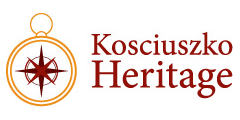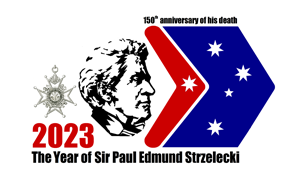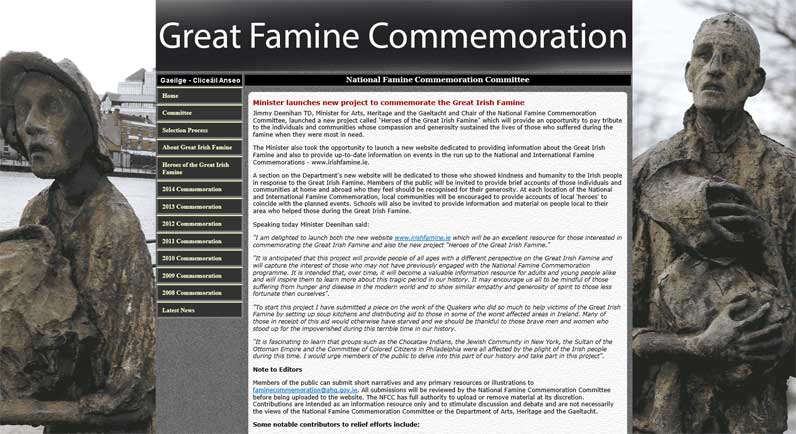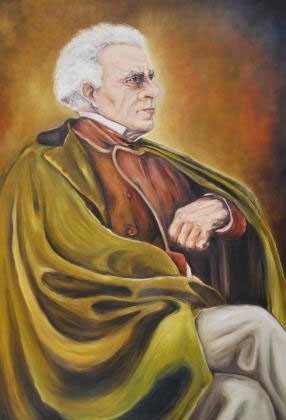Kosciuszko Heritage has made a submission to the Irish Government proposing that Paul Edmund Strzelecki be considered one of the heroes of the Great Irish Famine. (Please scroll down to read the submission.)
The proposal comes in response to Government’s announcement and launch of a program to recognise individuals who helped the Irish people during the Great Famine. Titled Heroes of the Great Irish Famine, the project is part of the 2014 National Famine Commemoration programme.
Kosciuszko Heritage has proposed Paul Edmund Strzelecki to be considered as one of the heroes, in light of Strzelecki’s significant humanitarian efforts that saved thousands of people in a time of extreme hardship.
The submission notes that Strzelecki developed a ground-breaking system to feed and clothe children through the schools that they attended. “When his plan was applied to the 27 Irish Unions in which starvation was most severe, the scheme, at its peak, fed and clothed 201,427 children of all religious persuasions every day,” the submission notes.
For more information about the Heroes project, see the website of the Great Famine Commemoration, run by the Department of Arts, Heritage and the Gaeltacht.
Click here to read the PDF version of the submission.
Heroes of the Great Irish Famine: Paul Edmund Strzelecki
Paul Edmund Strzelecki, one of the heroes of the Great Irish Famine,15 brought starving children into the foreground of relief measures. Filled with empathy for their plight, he devised an innovative system of feeding and clothing children through schools. When his plan was applied to the 27 Irish Unions in which starvation was most severe, the scheme, at its peak, fed and clothed 201,427 children of all religious persuasions every day.
Strzelecki, a scientist and world explorer, arrived in England in 1845 to publish A Physical Description of NSW and Van Diemen’s Land,17 based on four years of pioneering geological and mineralogical research of south-eastern Australia, for which he crossed over 11,000 km of rugged territory and inhospitable climate on foot while laden with scientific instruments.8 With the assistance of his Aboriginal guides, Paul Edmund peacefully and respectfully entered tribal territories by permission, not force.18
Shortly after Strzelecki’s book was published, news of the Great Hunger in Ireland began to break out. Paul Edmund, who had experienced 22 days of starvation while exploring Gippsland in 1840,9 was imbued with a sense of duty. He volunteered his time and talent – free of charge and at his own expense 10 – to the British Relief Association (BRA), a private charity that had recently been established by a group of English nobles to help those in great need in Ireland and Scotland. Strzelecki’s assistance was welcomed and, on the 22nd of January, 1847, the Association assigned him to provide relief to the Counties of Donegal, Mayo and Sligo. Strzelecki wasted no time; he arrived in Dublin four days later.
Fit and accustomed to travelling in difficult circumstances, on foot if necessary,2,11 Strzelecki obtained firsthand knowledge throughout the rural and settled districts of the Counties for which he was responsible to provide help. What he discovered tore at his heartstrings. During his first six months, he wrote 15 reports using the most powerful prose to describe what he had witnessed. Utter destitution and widespread mortality from starvation and disease were so grave that there was an insufficiency of coffins for those who had died.12
Traumatic memories of being orphaned awoke when he witnessed the plight of the children. His father had died when he was four and his mother when he was ten. At Westport, on the 29th of January, 1847, Strzelecki wrote:
“Of the fate gloomy and awful, which overhangs the whole population, that of the poor children, and the babies at the breasts of their emaciated and enervated mothers, excites the highest feelings of commiseration.” 13
Initially, as an agent of the BRA, Strzelecki was responsible for establishing depots from which food, provisions and clothing were gratuitously distributed to the destitute and starving. Paul Edmund had noted the dispersed nature of the population, so he established substations to make sure that the destitute in his Counties did not have too far to travel to obtain assistance. Alert to the waste and corruption that sometimes accompanied ‘relief’, Strzelecki was assiduous with the resources for which he was responsible. Areas with honest and efficient administrators were given priority,14 and rigorous control procedures were put in place. Only about 2% of BRA funds were absorbed by administrative costs,7 a contrast to the 30% or so expended by many major charities today.19
Strzelecki contracted typhus in March 1847, in the course of undertaking his charitable work. Although he continued to suffer ill effects for the rest of his life, his humanitarian efforts in Ireland continued unabated. He closely monitored conditions within his districts. Whenever the British Government made changes to Official Relief, such as when it closed Public Works and condemned to starvation those arbitrarily laid off, Strzelecki immediately doubled the Grants in his districts to help those affected by the Government’s heartlessness.3
Having installed and organised depots and procedures for the efficient distribution of food, clothing and grants to aid the destitute and starving adults, Strzelecki turned his attention to the plight of the children, whose situation had been tearing at his heartstrings. As an agent of the BRA, he had access to all the food and clothing needed; but how could it be delivered effectively to the children? Strzelecki’s innovative plan was simple and revolutionary. Clothing and daily food rations could be provided to children attending schools of all religious persuasions! The infrastructure and staff already existed; all that was needed was the approval of school authorities.
Strzelecki pioneered the idea of child relief through schools at Westport, County Mayo. A Poor Law Inspector was appointed to administer the allocation of food and clothing at the schools with the assistance of an equal balance of Catholic and Protestant associates. Safeguards were put in place to minimise abuse. It was a priority to make sure that there was no religious ‘litmus test’ or pressure for conversion. A school would be disqualified from the scheme if it did not adhere to the policy stipulating that:
“. . . this relief is given to alleviate the existing distress, and not for any religious or other purposes; that schools for children of every persuasion shall be placed on an equal footing as regards the participation of this bounty, and be dealt with according as they shall be more or less in need of relief.” 15
Sound hygiene procedures were introduced; the washing of hands and faces before meals was insisted on; water, towels, soap and combs were supplied.
The scheme proved to be a resounding success. Its innovator noticed that not only did child beggars disappear from the streets, but that parents, relieved of the anxiety of looking after their children, seemed revitalised and began to seek work actively. As a consequence, the children, and any parents who could stay out of the overcrowded, lice-infested workhouses, significantly boosted their chances of remaining disease-free and surviving the crisis.
By the end of June 1847, Strzelecki was appointed by the British Relief Association to be its chief executive officer for all Ireland, with Dublin as his headquarters. He immediately petitioned the Association to have his school scheme adopted across Ireland. The BRA Committee resisted at first, because of the opinion of Charles Trevelyan, the chief of Government Relief Programs, who strongly opposed the idea. Strzelecki, however, wrote a long letter putting forward compelling arguments for the scheme’s adoption. A few days after he sent the missive, on the 28th of October, 1847, the Committee decided in favour of Strzelecki. Over the course of time, the scheme was adopted in 27 of the most destitute Unions.
The rapid increase in the number of students enrolled at schools participating in the scheme is a significant indicator of its widespread approval and success. Two months after the scheme was implemented, 58,000 were enrolled; in March 1848, the number had increased to 176,000; two months later, the enrolment numbers peaked at 201,427 children of all religious persuasions, who were being fed and clothed at schools in the 27 poorest Unions. Further attesting to the success of Strzelecki’s school scheme, the Committee of the British Relief Association began to receive favourable testimonials from across Ireland from scheme implementers and supporters of the schools. Writing independently of each other, from different locations at different times, each of them made similar conclusions, including observations that were made after surprise visits to the schools in the Unions. The common threads in these positive comments mirrored Strzelecki’s earlier observations at Westport. Child beggars on the streets disappeared and parents, knowing that their children would be fed, clothed, taught and looked after every day, began to look for work to improve their own conditions. Strzelecki and the BRA Committee also began to receive messages of appreciation from community leaders, volunteers and the Government, all praising – in the highest terms – the effectiveness of the idea of feeding children through the medium of schools. No doubt Strzelecki’s school scheme saved an incalculable number of lives, child and adult, reducing by the thousands the number of deaths from starvation and disease.5
Paul Edmund Strzelecki was not only concerned with relieving the hunger of the day; he took measures to reduce the risk of history repeating itself. For example, rather than the population relying on potatoes as a single crop, he thought it a good idea for land tillers to diversify into turnips, and encouraged the BRA to buy as much turnip seed as possible, seeing it as a means of regenerating Ireland. More importantly, Strzelecki had correctly concluded that it was Britain’s oppressive land laws that were the real cause of the Great Hunger. When asked by the Quaker and liberal statesman John Bright about this matter during his second stint in Ireland, he stated that:
“If the Devil himself exercised all his ingenuity to invent a scheme which should destroy the country, he could not have contrived anything more effectual than the principles and practices upon which landed property has been managed and held in Ireland”.16, 20
Strzelecki was not frightened of speaking truth to power and alluded to the oppressive land laws imposed by Britain on Ireland when he gave evidence to a Select Committee of the House of Lords, on the 4th of May, 1849. 1,5
As a matter of interest, Strzelecki was knighted by Queen Victoria on the 11th of November, 1849, for his humanitarian work in Ireland and not for his scientific discoveries. A more poignant tribute was made by the Irish historian William O’Brien, born in the 19th Century, who stated that:
“The extent and value of the varied services rendered by Count Strzelecki in the conduct of the several operations entrusted to him were thoroughly appreciated and gratefully acknowledged by all those with whom his mission of charity had brought him into personal communication, and in many of the remotest and most afflicted districts of the west, to which his solicitude had been primarily and chiefly attracted, the name of this benevolent foreigner was then, and for long afterwards, a familiar one, if not a household word, in the homes of the suffering poor.” 6
A more succinct tribute is expressed by the historian Christine Kinealy in the 21st Century:
“Strzelecki, a Polish nobleman with no connection to Ireland, perhaps more than any other individual personified a spirit of selflessness and sacrifice that had helped to save an untold number of Irish lives.” 4
Bibliography
1. Fourth Report from the Select Committee on Poor Laws (Ireland), Together with the Proceedings of the Committee, Minutes of Evidence, Appendix and Index. House of Commons, July, 1849.
2. Kinealy, C., Charity and the Great Hunger in Ireland: The Kindness of Strangers. London, Bloomsbury Academic 2013, p. 174.
3. Idem, p. 29.
4. Idem, p. 193.
5. Molski, F. The Best of Human Nature, Kosciuszko Heritage Inc. Sydney 2012.
6. O’Brien, W.P. ‘The Great Famine in Ireland’, London, Downey & Co., 1896, p. 190.
7. O’Rourke, C. J., The Great Irish Famine. Dublin, Veritas Publications (abridged edition), 1989, p. 262.
8. Paszkowski, L., Sir Paul Edmund de Strzelecki. Melbourne, Australian Scholarly Publishing, 1997, p. 212.
9. Idem, p. 122.
10. Idem, p.194.
11. Report of The British Association for the Relief or The Extreme Distress in Ireland and Scotland, London, Richard Clay, 1849, p. 93.
12. Idem, p. 91
13. Idem, p. 92.
14. Idem, pp. 103-104.
15. Idem, pp. 186-187.
16. Skurjat-Kozek, E. and Molski, F. P E de Strzelecki’s humanitarian deeds at the Irish Famine 1846. http://youtu.be/98Nuh_fFjZI
17. Strzelecki, P. E. de, Physical Description of New South Wales and Van Diemen’s Land, London, Longman, Brown, Green & Longmans. 1845.
18. Idem, p. 340.






![Count Paul Edward [sic.] Strzelecki (copyright: the State Library of Victoria)](https://www.kosciuszkoheritage.com/public_html/wp-content/uploads/2014/11/2014_06_20.jpg)

